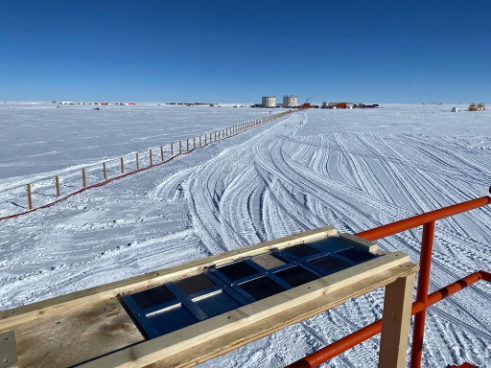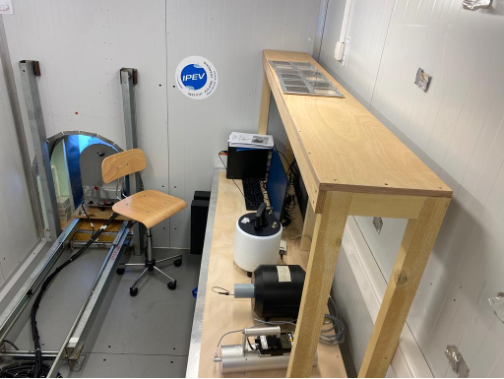- Acronimo
- CORDIAL
- Codice
- PNRA18_00190
- Anno
- 2018
- Area di ricerca
- Universe
- Tematica specifica di ricerca
- Dosimetry of Cosmic Rays in Antarctic latitudes to study their contribution to induced radiation
- Regione di interesse
- Concordia base (one of the most sensitive places of the Planet to the effects of space weather)
- PI
- Fabio Romanelli
- Istituzione PI
- Dipartimento di Matematica e Geoscienze - Università degli Studi di Trieste
- Sito web istituzionale
- https://dmg.units.it
- Altre Istituzioni e soggetti coinvolti
- INAF (Roma, Torino, Trieste); UNITO; INFN (Bologna, Torino, Trieste)
- Consistenza del team ricerca
- Stato progetto
- In corso
- Stazioni principali usate
- Concordia
- Il progetto
Galactic and solar cosmic rays (CR) are important components of the ionizing radiation that affects the Earth's environment [1]. Because of the geomagnetic field shape, the polar regions are the most exposed to secondary cosmic rays, produced by CR’s interaction with atmospheric nuclei.
The Antarctic region is an ideal place to study the contribution of CR induced radiation in a wide variety of conditions, because the Antarctic bases are located at different latitudes and altitudes (from sea level up to 3300 m on the Plateau) and at different distances from the south magnetic pole. In particular, Concordia base is one of the most sensitive places of the Planet to the effects of space weather.This project, based on a multidisciplinary approach (radiation dosimetry, atmosphere physics, solar physics, space weather) proposes: 1-the first study of Ambient Dose Equivalent (H*) due to different components of secondary CR radiation on the Antarctic Plateau, by using different passive and active detectors, able to separately detect gamma rays, low and high energy neutrons, charged particles.
2- The analysis of short and medium term correlation between environmental dose and primary CR modulation, solar activity, geomagnetic field variability and antarctic atmosphere parameters.
3- The measurement of the induced radiation doses relevant for the biological effects on the human body in the Polar Regions.
- Immagini
-
- Motivazione, importanza della ricerca
The CORDIAL project, based on a multidisciplinary research group, is devoted to the following goals:
1- to overcome the lack of dosimetric data at high southern latitudes, with a campaign of measurements of the various components of secondary radiation that contribute to the total environmental ambient dose equivalent H*; active and passive radiation dosimeters will be used, with special attention to the secondary neutron component;
2- to study the dependence of H* from geophysical parameters (latitude and altitude) and atmospheric parameters (composition and dynamics of Antarctic atmosphere) and to analyze the correlation between H* rate with solar activity , geomagnetic field, interplanetary magnetic field, in particular for what concerns human being long term low radiation dose exposure.
Four research units (RUs) are involved in the development of this project:
1)UNIV-TS : Tasks of coordination of all the activities, instruments purchasing, testing, delivery, installation, retrieval, data analysis, simulations.
2)INAF/Roma(IAPS)-Torino(OATO)-Trieste(OATS) will study cosmic ray and solar variability monitoring, SEP events, participating in data collection and analysis.
3)UNIV-TO - The task of this unit is to support the project with the analysis of meteorological data over Antarctica from local or global observations and models.
4)INFN/BO-TO-TS. The INFN Unit will perform instruments calibration and tests, data analysis of active and passive detectors and the comparison of the results with other experiments.
The RUs will contribute to the achievement of scientific objectives through their specific expertise and methodologies, widely recognized in the scientific national and international contexts. The themes of the project are described below and organized according to two main lines of research, which will be developed in a coordinated and integrated work by the RUs, although each one will focus on specific aspects.
LINE A – Environmental radiation spectrometry and dosimetry
Because of the geomagnetic field shape, the polar regions are the most exposed to secondary cosmic rays, produced by CR’s interaction with oxigen and nitrogen atmosphere nuclei.
According to the present literature, few dosimetric data are available in the Antarctic region; only recently [2] (Zanini et al., 2017), some interesting results are published (by some of the same scientists of the present project) on a dosimetric campaign performed at the Argentine Antarctic Marambio base by IAA, the Antartic Argentinian Institue (March-October 2015).
Hence, a proper measurement of the different components of secondary cosmic ray radiation dose will be performed at the Dome C base, the place of the Planet most sensitive to the effects of space weather, because of its altitude and latitude. Dosimetric data will be used to investigate the almost unexplored field such as the variation of environmental radiation dose with geophysics parameters in the Antarctic region and the correlation with primary CR modulation, solar activity, geomagnetic field variability and the antarctic atmosphere parameters.
Results in terms of radiation fluxes and doses will be correlated with results obtained by other RU’s.
The INFN Unit ( Bologna, Torino, Trieste) has a specific competence in radiation dosimetry, both with passive detectors (track detectors, bubble detectors) [5] and active detectors (REM counters, Liulin LET spectrometer).[6-8].
In particular at BO INFN is available a complete system for chemical etching and analysis by microscope of nuclear track detectors NTD (as makrofol, mylar, CR39 foils), used in different fields of astroparticle and nuclear physics, as searches for magnetic monopoles, nuclearites and other exotica and in the determination of the charge spectrum of primary cosmic ray particles.At TO-INFN a neutron spectrometry and dosimetry technique in extended energy range ( 0.0025 eV - 200 GeV) has been developed by using a set of different neutron detectors, based on bubble dosimeters for thermal and fast neutrons, CR39 foils for intermediate energy neutrons and a Bi209 fission detector for relativistic neutrons. This spectrometric system has been properly calibrated at the CERF [9] facility and successfully used in several experiments aimed to cosmic ray induced neutron dosimetry, high altitude laboratories, stratospheric balloons (ASI), satellites (FOTON M3 ESA), International Space Station (STS-134 Endeavour mission) [10-14].
Dosimetry of different radiation components will be performed by using active and passive detectors.
- Obiettivi della proposta
This research project aims to study, in the light of recent scientific and technological developments, the radiation dose response of the atmosphere to variations of solar and galactic cosmic rays on short and medium time scales, ranging from a few hours to several months. In this context, the main objectives can be summarized as follows:
1)Assessment of cosmic ray induced environmental radiation dose at high altitude and latitude (Concordia Base) with a special attention to the neutron contribution, and comparison with dosimetric experiments carried out in other locations at high Southern latitudes.2)Monitoring of CR flux variations during the data collection period and analysis of the main features of SEP and GLE events.
3)Study of correlation of the ambient dose equivalent (H*) rate with the primary cosmic ray variability and with solar events, based on experimental data and Montecarlo simulation of the secondary particles generation and propagation in the atmosphere, taking into account the specific dynamics and composition of the Antarctic atmosphere.
4)Better understanding of the space weather effects on the environmental dose and assessment of the risk of increasing radiation dose during solar eruptions.
- Attività svolta e risultati raggiunti
The research will be carried out by using our experimental data and combined with the observations of the primary CR’s, both by satellite (for SEPs) and polar neutron monitors, and with the help of simulations (e.g., using the GEANT4 code) describing their interaction with the terrestrial environment.
Considering the dosimetric data collection special attention will be payed to neutron spectrometry and dosimetry. In particular the neutron spectrum in the range from 0.025 eV to 200 GeV will be obtained from measurements recorded by the proposed passive dosimetry system. Simultaneously, it will be measured in real time the Ambient Dose Equivalent through traditional rem-counters (0.0025 eV-17 MeV) and extended rem-counter (0.025 eV – 1 GeV). For completeness, it will be measured also the dose due to low LET (Liulin instrument) particles and the electromagnetic component. The observations will be compared with the GEANT4 simulations.
- Prodotti
Scientific papers, describing the following technical deliverables:
Monitoring of solar and interplanetary conditions
Analysis of CR variability
Features of SEP events
Calibration and dosimetric instrumentation test at LNF and high altitude laboratories (Testa Grigia, Cervinia, (3480 m, 45-56N, 7-42E) - Zugspitze, Monaco, Germania (2962 m , 47-25N, 10-59E))
Installation and dosimetric instrumentation test at the Antarctic Concordia Base (3233 m 74° 30 S 123° 0 E)
MC GEANT4 simulations and comparison with experimental data
Correlation analysis between measured dose and solar events
Distribution of radiation in Antarctica
Dosimetric mapping

